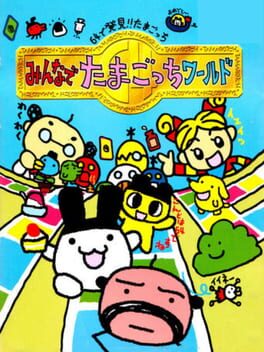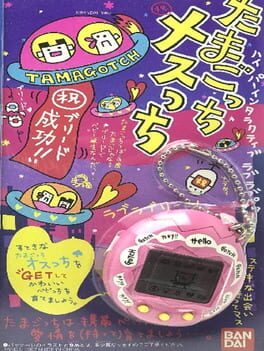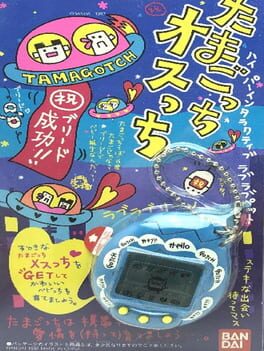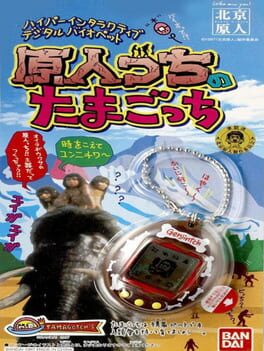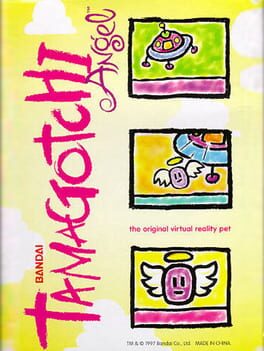

Tamagotchi 64: Minna de Tamagotchi World is a Nintendo 64 game released only in Japan in 1997. It is a virtual board game based on the Tamagotchi toy.
Also in series
Reviews View More
This is a game I’ve seen around in Book Off and such for super cheap for years now, but I’ve never really paid it any mind. It was only a few days back that I actually sat down and looked up what this game actually was, and much to my surprise, it’s a Mario Party-clone by HudsonSoft!? Now, to be more accurate, though Hudson did co-develop it, so far as I can tell, the main developer was Bandai, and this shares virtually no staff the series that would eventually be Mario Party (as this came out in 1997, one year before the first Mario Party). Regardless, seeing how weird and bad these types of games can be is something I love doing, and it just so happens that my partner also is a huge Tamagotchi fan, so snagging this for the 100 yen it was going for was an absolute no-brainer. This game doesn’t really have a single-player mode as such, and you can actually view the credits whenever you want in the options menu, so I just played until I won a round and called this one “beaten” (and then played a few more rounds after that for good measure). I spent about 4 or so hours playing it on real hardware.
This game actually does have a narrative of sorts despite such a thing being so generally unnecessary in a party game like this. Professor Banzou, the man who discovered Tamagotchi, is brooding on a bridge, cursing his bad luck with the ladies despite the great discovery he’s made. All of a sudden, a tiny spaceship full of Tamagotchi (in the middle of fighting over food) fall down from orbit and crash into his head, knocking him into the river. As he’s shouting at them for hurting him, he’s struck with a brilliant idea, and runs off to his laboratory to begin work. A week later, he’s developed a new type of Tamagotchi House, a large-size one that can accommodate four Tamagotchi at once! And such is the excuse for why four Tamagotchi are about to compete to see who can grow up the fastest in this giant new Tamagotchi house XD. It’s a very silly story and not really necessary to make the game work or anything, but it’s very charmingly animated (not to mention totally voice acted, which is pretty darn impressive for the N64 in ’97), and it sets up the action just fine.
The actual gameplay of Tamagotchi 64 (as I’m going to be referring to it here for the sake of brevity) is certainly Mario Party-ish in that it’s a four-player board game with mini-games as well, but it’s ultimately not that much like Mario Party (and is a lot more like later Tamagotchi party games would be, as it so happens). Your goal, as eluded to earlier, is to be the first to completely grow up, which here means to fill up the power meter four times. The game has only one board, and the four of you go around this board by rolling a die and landing on spaces. There are spaces that just make your power meter go up and down, ones that give you special item cards to use whenever you want, and even ones that activate a mini-game for you all to play, but no matter what you land on, you then get to take care of your Tamagotchi. Just like the little PDA-like toys, Tamagotchis have food and play meters that need to be taken care of, and when they’re sick they need curing, when they’re bad (refuse to eat or play) they need scolding, and when they’ve pooped you’ve gotta clean it up. This is used by expending caring points, and you get a big refill of caring points by passing Go at the start of the board (or by landing on special fitness spaces).
While it’s all a bit complicated when you write it out on paper like this, it’s actually quite self-explanatory in practice. You generally want to feed your Tamagotchi when it’s hungry because that’s an easy way to get power points, and the play option (while costing less) activates a simple mini-game that can be lost, earning you nothing. Keeping your play and food meters high means you get more power points (I think?), and it’s just generally good for keeping your Tamagotchi happy and growing. However, despite how simple the gameplay actually is, the devil is reallly in the details here, and this game has some very stiff problems when it comes to its execution.
While there are little things like the lack of a pause button that just sorta generally suck, the main issue with this game is that a LOT of your ability to win is based on how lucky you’re getting. Where you’re landing will dictate a lot of how much you’re growing (or not growing), and how good your luck is there will determine the pace of the game a LOT. You don’t have a star to purchase like in Mario Party to aim for, so that really focuses a lot of the game’s momentum on turn-to-turn gameplay. This means it can feel really discouraging if you’re just having awful luck and/or the other players are beating up on you a lot (with card-items or other such things).
Compared to something like Mario Party, where there’s a (usually) skill-based mini-game at the end of every turn, mini-games in Tamagotchi 64 are very rare, as they require landing on a special space to activate. This isn’t even mentioning how the mini-games themselves may not be awful, but they do suffer very badly in a non-multiplayer environment. The CPUs are just SO impossibly good at so many of them that it feels pointless to even try a lot of the time (and these CPUs also lack any difficulty selections either). The icing on the cake there is that not only do the mini-games have no practice option, but they also don’t have a prompt to go past the instructions screen to start playing them. That instructions screen is only on screen for 3 or 4 seconds, so you better read and understand them quick if you wanna actually have a chance of winning! <w>
Summing it up succinctly, there just isn't a lot a player can do to actually affect their chances of winning. Just so much of the game is simply down to luck that it makes you wonder why you should even try when you're losing. By that same token, the games are so generally short that you really may as well try, as the other players may soon tumble into the same bad luck that's been ruining your time for the past however long soon enough XD. I have my suspicions that there's an internal catchup mechanic where the computer will give good fortune to a certain player to make it so the end game has a bit more tension to it, but that's just a hypothesis, really. While simply getting lucky enough may be fine for a very simple children's board game, it makes for a very unsatisfying gameplay loop for a video game (especially playing by yourself against CPUs), so if you're going to have a really fun time with this one, friends are very highly recommended.
The presentation, at least, is very well done. Not only are the opening and ending cutscenes voice acted for Professor Banzou and his assistant Mikachu, but the game has a great and pumping soundtrack too. I can’t help but watch the intro every time I boot up the game because the music is just so much fun x3. It even has a vocal track that plays during special scenes, which is an achievement in and of itself for the N64. The graphics are also really good. They’re very evocative of both the general art style of Tamagotchi as well as of the little digital pet toys themselves (with the play-command mini-games even having bleep-bloop sound effects to go with them just like the digital pet toys do x3). The game’s screen has the board game down below and a little view to the pets themselves up top, and watching their idle animations (from feeling hungry to just playing around in a giant udon bowl) while they wait for their turn is absolutely adorable. Every Tamagotchi has bespoke animations for those little idle bits as well, so it really makes them come to life in a way that fits the setting perfectly.
Verdict: Hesitantly Recommended. This isn’t a bad game, and I definitely feel I got my money’s worth for the 100 yen I paid for it, but it’s definitely difficult to recommend at the end of the day. The relatively unsatisfying gameplay loop combined with only a dozen or so mini-games and just a singular board to play on means that the game starts to feel stale quite fast. While what’s here isn’t necessarily awful, even on its worst day, that doesn’t really change how there are still much better options on this console for party games in a board game style. If you’re a big Tamagotchi fan or a big Mario Party fan, then this one might be worth checking out, but if you’re more of a casual party game fan (and especially if you have no one to play with), then this is probably a game that’s going to end up giving you more frustration than fun at the end of the day.
This game actually does have a narrative of sorts despite such a thing being so generally unnecessary in a party game like this. Professor Banzou, the man who discovered Tamagotchi, is brooding on a bridge, cursing his bad luck with the ladies despite the great discovery he’s made. All of a sudden, a tiny spaceship full of Tamagotchi (in the middle of fighting over food) fall down from orbit and crash into his head, knocking him into the river. As he’s shouting at them for hurting him, he’s struck with a brilliant idea, and runs off to his laboratory to begin work. A week later, he’s developed a new type of Tamagotchi House, a large-size one that can accommodate four Tamagotchi at once! And such is the excuse for why four Tamagotchi are about to compete to see who can grow up the fastest in this giant new Tamagotchi house XD. It’s a very silly story and not really necessary to make the game work or anything, but it’s very charmingly animated (not to mention totally voice acted, which is pretty darn impressive for the N64 in ’97), and it sets up the action just fine.
The actual gameplay of Tamagotchi 64 (as I’m going to be referring to it here for the sake of brevity) is certainly Mario Party-ish in that it’s a four-player board game with mini-games as well, but it’s ultimately not that much like Mario Party (and is a lot more like later Tamagotchi party games would be, as it so happens). Your goal, as eluded to earlier, is to be the first to completely grow up, which here means to fill up the power meter four times. The game has only one board, and the four of you go around this board by rolling a die and landing on spaces. There are spaces that just make your power meter go up and down, ones that give you special item cards to use whenever you want, and even ones that activate a mini-game for you all to play, but no matter what you land on, you then get to take care of your Tamagotchi. Just like the little PDA-like toys, Tamagotchis have food and play meters that need to be taken care of, and when they’re sick they need curing, when they’re bad (refuse to eat or play) they need scolding, and when they’ve pooped you’ve gotta clean it up. This is used by expending caring points, and you get a big refill of caring points by passing Go at the start of the board (or by landing on special fitness spaces).
While it’s all a bit complicated when you write it out on paper like this, it’s actually quite self-explanatory in practice. You generally want to feed your Tamagotchi when it’s hungry because that’s an easy way to get power points, and the play option (while costing less) activates a simple mini-game that can be lost, earning you nothing. Keeping your play and food meters high means you get more power points (I think?), and it’s just generally good for keeping your Tamagotchi happy and growing. However, despite how simple the gameplay actually is, the devil is reallly in the details here, and this game has some very stiff problems when it comes to its execution.
While there are little things like the lack of a pause button that just sorta generally suck, the main issue with this game is that a LOT of your ability to win is based on how lucky you’re getting. Where you’re landing will dictate a lot of how much you’re growing (or not growing), and how good your luck is there will determine the pace of the game a LOT. You don’t have a star to purchase like in Mario Party to aim for, so that really focuses a lot of the game’s momentum on turn-to-turn gameplay. This means it can feel really discouraging if you’re just having awful luck and/or the other players are beating up on you a lot (with card-items or other such things).
Compared to something like Mario Party, where there’s a (usually) skill-based mini-game at the end of every turn, mini-games in Tamagotchi 64 are very rare, as they require landing on a special space to activate. This isn’t even mentioning how the mini-games themselves may not be awful, but they do suffer very badly in a non-multiplayer environment. The CPUs are just SO impossibly good at so many of them that it feels pointless to even try a lot of the time (and these CPUs also lack any difficulty selections either). The icing on the cake there is that not only do the mini-games have no practice option, but they also don’t have a prompt to go past the instructions screen to start playing them. That instructions screen is only on screen for 3 or 4 seconds, so you better read and understand them quick if you wanna actually have a chance of winning! <w>
Summing it up succinctly, there just isn't a lot a player can do to actually affect their chances of winning. Just so much of the game is simply down to luck that it makes you wonder why you should even try when you're losing. By that same token, the games are so generally short that you really may as well try, as the other players may soon tumble into the same bad luck that's been ruining your time for the past however long soon enough XD. I have my suspicions that there's an internal catchup mechanic where the computer will give good fortune to a certain player to make it so the end game has a bit more tension to it, but that's just a hypothesis, really. While simply getting lucky enough may be fine for a very simple children's board game, it makes for a very unsatisfying gameplay loop for a video game (especially playing by yourself against CPUs), so if you're going to have a really fun time with this one, friends are very highly recommended.
The presentation, at least, is very well done. Not only are the opening and ending cutscenes voice acted for Professor Banzou and his assistant Mikachu, but the game has a great and pumping soundtrack too. I can’t help but watch the intro every time I boot up the game because the music is just so much fun x3. It even has a vocal track that plays during special scenes, which is an achievement in and of itself for the N64. The graphics are also really good. They’re very evocative of both the general art style of Tamagotchi as well as of the little digital pet toys themselves (with the play-command mini-games even having bleep-bloop sound effects to go with them just like the digital pet toys do x3). The game’s screen has the board game down below and a little view to the pets themselves up top, and watching their idle animations (from feeling hungry to just playing around in a giant udon bowl) while they wait for their turn is absolutely adorable. Every Tamagotchi has bespoke animations for those little idle bits as well, so it really makes them come to life in a way that fits the setting perfectly.
Verdict: Hesitantly Recommended. This isn’t a bad game, and I definitely feel I got my money’s worth for the 100 yen I paid for it, but it’s definitely difficult to recommend at the end of the day. The relatively unsatisfying gameplay loop combined with only a dozen or so mini-games and just a singular board to play on means that the game starts to feel stale quite fast. While what’s here isn’t necessarily awful, even on its worst day, that doesn’t really change how there are still much better options on this console for party games in a board game style. If you’re a big Tamagotchi fan or a big Mario Party fan, then this one might be worth checking out, but if you’re more of a casual party game fan (and especially if you have no one to play with), then this is probably a game that’s going to end up giving you more frustration than fun at the end of the day.
I would only recommend it to fans of Tamagotchi, and even then, this still isn't that good. turns can feel slow without much going on, and the CPUs felt hard, at least to me in the one game I played. there's also only one board. also if you're playing on emulator, the Reizokotchi space softlocks the game, and since I was on emulator, I had to keep trying to manipulate RNG so that no one ever landed on one. btw, Tamagotchi can actually die in this game if you don't take care of it properly, and if all player ones die (it's hard to do that btw), the game just ends with a game over screen with Mikachu saying something like "Souna!!!" before going back to the title screen.
overall, it isn't great, there isn't much replay value, especially since there's only 1 board, but if you wanna see it, go ahead
overall, it isn't great, there isn't much replay value, especially since there's only 1 board, but if you wanna see it, go ahead
Tamagotchi World (or Discovered at 64! Tamagotchi Everyone at Tamagotchi World for the full translation of the name) is a board game-based video game. Players take turns rolling dice, land on spaces which help or hinder progression and every now and then take part in solo or 4 player minigames. It sounds a lot like Mario Party, but before Mario Party – it’s even made by Hudson Soft.
This isn’t just about moving around the board, you have to raise your Tamagotchi as well. After your move, you can input options based on the classic devices such as feed, play, heal and clean poop. You need to maintain your Tamagotchi’s status bars as well as gain points to level up – reaching the max wins you the game.
Sometimes your Tamagotchi will refuse what to do, so you’ll need to discipline them. You also have limited credits, which are refilled once you get back to the starting point. It’s an interesting mechanic that gives you a lot more to think about other than rolling and moving.
When players land on certain spots, a minigame will be triggered. There are only 10 minigames, but they wouldn’t feel out of place in Mario Party (one even has you spinning the analogue stick as fast as you can).
This is an interesting precursor to Mario Party, and the Tamagotchi elements, while still entirely luck based, make it more than just a roll and move game.
This isn’t just about moving around the board, you have to raise your Tamagotchi as well. After your move, you can input options based on the classic devices such as feed, play, heal and clean poop. You need to maintain your Tamagotchi’s status bars as well as gain points to level up – reaching the max wins you the game.
Sometimes your Tamagotchi will refuse what to do, so you’ll need to discipline them. You also have limited credits, which are refilled once you get back to the starting point. It’s an interesting mechanic that gives you a lot more to think about other than rolling and moving.
When players land on certain spots, a minigame will be triggered. There are only 10 minigames, but they wouldn’t feel out of place in Mario Party (one even has you spinning the analogue stick as fast as you can).
This is an interesting precursor to Mario Party, and the Tamagotchi elements, while still entirely luck based, make it more than just a roll and move game.
